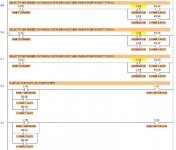dbh6
Lifetime Supporting Member
Software is RSlogix 5000
Ok I have been trying to get this ladder code working without making it to complicated but keep running into road blocks. Ill explain the scenario so i can get pointers from you folks.
Below i have outlined the spec:
- Their are a total of 4 pumps. lets call them PumpA, PumpB, PumpC and PumpD.
- It is required that 2 pumps have to be on while the other 2 have to be on standby.
- user should be able to select which two pumps out of the four they want on standby.
-Lastly, say for example you have PumpA and PumpB running and PumpC and PumpD on standby, if PumpB fails then the next available standby pump should come on, in this case either PumpC or PumpD is fine, but when that failed PumpB comes out of a failed state, that will be the new standby. This same principal applies to any pump that fails
So please share you thoughts on this, as i have spent too much time on it and got nothing but dead ends.
Ok I have been trying to get this ladder code working without making it to complicated but keep running into road blocks. Ill explain the scenario so i can get pointers from you folks.
Below i have outlined the spec:
- Their are a total of 4 pumps. lets call them PumpA, PumpB, PumpC and PumpD.
- It is required that 2 pumps have to be on while the other 2 have to be on standby.
- user should be able to select which two pumps out of the four they want on standby.
-Lastly, say for example you have PumpA and PumpB running and PumpC and PumpD on standby, if PumpB fails then the next available standby pump should come on, in this case either PumpC or PumpD is fine, but when that failed PumpB comes out of a failed state, that will be the new standby. This same principal applies to any pump that fails
So please share you thoughts on this, as i have spent too much time on it and got nothing but dead ends.





